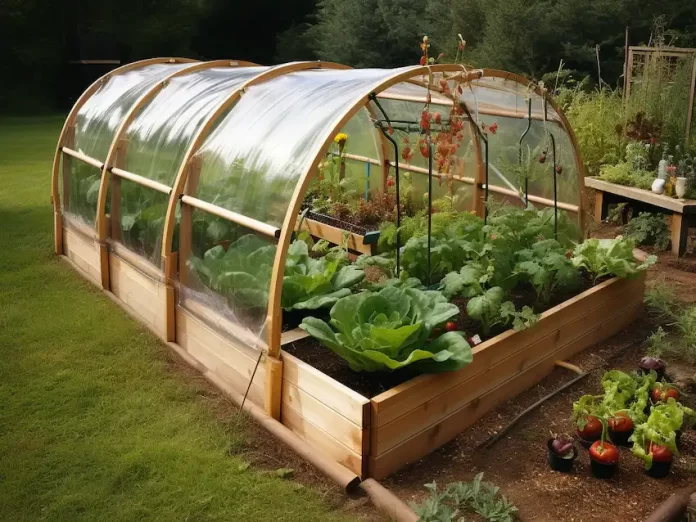Constructing a hinged hoophouse for your raised bed garden offers a fantastic means to prolong your growing season, shield your plants from adverse weather conditions, and fend off pests. This comprehensive guide will lead you through the process of assembling a hinged hoophouse, ensuring that even novices can follow along and achieve exceptional outcomes.
Materials Required
- PVC pipes (1/2 inch diameter)
- Heavy-duty plastic sheeting (6 mil)
- Hinges
- Stainless steel screws
- Wooden planks (for the raised bed frame)
- Pipe clamps
- UV-resistant zip ties Tools: Drill, saw, measuring tape, staple gun
Instructions
- Prepare Your Raised Bed : If you haven’t already, build your raised bed using wooden planks, ensuring its solidity and optimal placement in your garden, ideally in a sunny spot. The dimensions of your raised bed will dictate the size of your hoophouse, so plan accordingly.
- Measure and Cut PVC Pipes : Measure the width of your raised bed and cut PVC pipes to form hoops spanning across it. The number of hoops needed will depend on the length of your bed; aim for a hoop every 2-3 feet. Gently bend the pipes and insert their ends into the soil on both sides of the bed or affix them to the wooden frame with pipe clamps to create arches.
- Install Hinges : Designate one side of the raised bed as the fixed base of your hoophouse. On the opposite side, where the entrance will be, attach hinges to the wooden frame. These hinges will enable easy opening and closing of the hoophouse for plant access.
- Attach PVC Pipes to Hinges : Secure the PVC pipes to the hinged side of the raised bed using screws and pipe clamps. Ensure a firm attachment, allowing the structure to swing open and close smoothly.
- Cover with Plastic Sheeting : Drape the heavy-duty plastic sheeting over the PVC hoops, leaving enough excess to cover the bed’s ends. Trim the plastic as necessary, leaving surplus material for securing it to the ground or frame.
- Secure the Plastic Sheeting : Use UV-resistant zip ties to tightly fasten the plastic sheeting to the PVC hoops. Staple the plastic to the wooden frame on the hinged side, ensuring it’s taut and secure. On the fixed side and ends, bury excess plastic in the soil or secure it to the frame to protect the interior from the elements.
- Final Adjustments : Test the hinged hoophouse by opening and closing it to ensure the plastic is neither overly stretched nor loose. Make any required adjustments to the hinges, plastic, or frame for improved functionality.
- Ventilation : To prevent overheating on sunny days, create ventilation by rolling up the side of the plastic sheeting or installing additional vents. This will help regulate temperature and humidity within the hoophouse.
Maintenance Tips
- Regularly inspect the structure for damage or wear, particularly after severe weather conditions.
- Replace the plastic sheeting as needed to maintain clarity and durability.
- Periodically lubricate the hinges for smooth operation.
Building a hinged hoophouse for your raised bed garden is a gratifying project that can significantly benefit your plants by providing a controlled environment. By following these detailed steps, you’ll create a functional and durable hoophouse that enhances your gardening experience. Whether extending your growing season or safeguarding plants from pests, a hinged hoophouse is a practical and effective solution.
